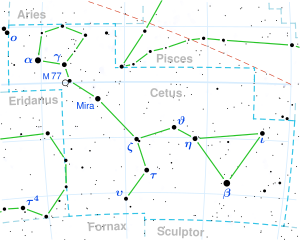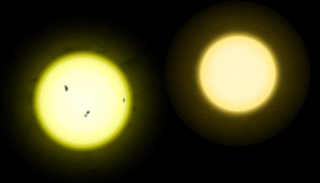Tau Ceti
 Tau Ceti (circled) in the south of the constellation Cetus. | |
| Observation data Epoch J2000 Equinox J2000 | |
|---|---|
| Constellation | Cetus |
| Pronunciation | /ˌtaʊ ˈsiːtaɪ/ |
| Right ascension | 01h 44m 04.08338s[1] |
| Declination | −15° 56′ 14.9262″[1] |
| Apparent magnitude (V) | 3.50 ± 0.01[2] |
| Characteristics | |
| Evolutionary stage | Main sequence |
| Spectral type | G8V[3] |
| U−B color index | +0.21[4] |
| B−V color index | +0.72[4] |
| Astrometry | |
| Radial velocity (Rv) | −16.68±0.05[5] km/s |
| Proper motion (μ) | RA: −1721.05[1] mas/yr Dec.: +854.16[1] mas/yr |
| Parallax (π) | 273.8097 ± 0.1701[6] mas |
| Distance | 11.912 ± 0.007 ly (3.652 ± 0.002 pc) |
| Absolute magnitude (MV) | 5.69±0.01[2] |
| Absolute bolometric magnitude (Mbol) | 5.52±0.02[2] |
| Details | |
| Mass | 0.783±0.012[2] M☉ |
| Radius | 0.793±0.004[2] R☉ |
| Luminosity | 0.52±0.03[7] L☉ |
| Luminosity (visual, LV) | 0.45[nb 1] L☉ |
| Surface gravity (log g) | 4.4[8] cgs |
| Temperature | 5,344±50[9] K |
| Metallicity | 28±3% Sun |
| Metallicity [Fe/H] | −0.55±0.05[10] dex |
| Rotation | 34 days[11] |
| Age | 5.8[12] Gyr |
| Other designations | |
| Database references | |
| SIMBAD | data |
| Exoplanet Archive | data |
| ARICNS | data |
Tau Ceti, Latinized from τ Ceti, is a single star in the constellation Cetus that is spectrally similar to the Sun, although it has only about 78% of the Sun's mass. At a distance of just under 12 light-years (3.7 parsecs) from the Solar System, it is a relatively nearby star and the closest solitary G-class star. The star appears stable, with little stellar variation, and is metal-deficient.
Observations have detected more than ten times as much dust surrounding Tau Ceti as is present in the Solar System. Since December 2012, there has been evidence of at least four planets—all confirmed being super-Earths—orbiting Tau Ceti, with two of these being potentially in the habitable zone.[13][14][15] There are an additional four unconfirmed planets, one of which is a Jovian planet between 3 and 20 AU from the star.[16] Because of its debris disk, any planet orbiting Tau Ceti would face far more impact events than Earth. Despite this hurdle to habitability, its solar analog (Sun-like) characteristics have led to widespread interest in the star. Given its stability, similarity and relative proximity to the Sun, Tau Ceti is consistently listed as a target for the Search for Extra-Terrestrial Intelligence (SETI) and appears in some science fiction literature.[17]
It can be seen with the unaided eye with an apparent magnitude of 3.5.[2] As seen from Tau Ceti, the Sun would be in the northern hemisphere constellation Boötes with an apparent magnitude of about 2.6.[nb 2][18]
Name[]
The name "Tau Ceti" is the Bayer designation for this star, established in 1603 as part of German celestial cartographer Johann Bayer's Uranometria star catalogue: it is "number T" in Bayer's sequence of constellation Cetus. In the catalogue of stars in the Calendarium of Al Achsasi al Mouakket, written at Cairo about 1650, this star was designated Thālith al Naʽāmāt (ثالث النعامات - thālith al-naʽāmāt), which was translated into Latin as Tertia Struthionum, meaning the third of the ostriches.[19] This star, along with η Cet (Deneb Algenubi), θ Cet (Thanih Al Naamat), ζ Cet (Baten Kaitos), and υ Cet, were Al Naʽāmāt (النعامات), the Hen Ostriches.[20][21]
In Chinese astronomy, the "Square Celestial Granary" (Chinese: 天倉; pinyin: Tiān Cāng) refers to an asterism consisting of τ Ceti, ι Ceti, η Ceti, ζ Ceti, θ Ceti and .[22] Consequently, the Chinese name for τ Ceti itself is "the Fifth Star of Square Celestial Granary" (Chinese: 天倉五; pinyin: Tiān Cāng wǔ).[23]
Motion[]
The proper motion of a star is its rate of movement across the celestial sphere, determined by comparing its position relative to more distant background objects. Tau Ceti is considered to be a high-proper-motion star, although it only has an annual traverse of just under 2 arc seconds.[nb 3] Thus it will require about 2000 years before the location of this star shifts by more than a degree. A high proper motion is an indicator of closeness to the Sun.[24] Nearby stars can traverse an angle of arc across the sky more rapidly than the distant background stars and are good candidates for parallax studies. In the case of Tau Ceti, the parallax measurements indicate a distance of 11.9 ly. This makes it one of the closest star systems to the Sun and the next-closest spectral class-G star after Alpha Centauri A.[25]
The radial velocity of a star is the component of its motion that is toward or away from the Sun. Unlike proper motion, a star's radial velocity cannot be directly observed, but can be determined by measuring its spectrum. Due to the Doppler shift, the absorption lines in the spectrum of a star will be shifted slightly toward the red (or longer wavelengths) if the star is moving away from the observer, or toward blue (or shorter wavelengths) when it moves toward the observer. In the case of Tau Ceti, the radial velocity is about −17 km/s, with the negative value indicating that it is moving toward the Sun.[26] The star will make its closest approach to the Sun in about 43,000 years, when it comes to within 10.6 ly (3.25 pc).[27]
The distance to Tau Ceti, along with its proper motion and radial velocity, together give the motion of the star through space. The space velocity relative to the Sun is 37.2 km/s.[28] This result can then be used to compute an orbital path of Tau Ceti through the Milky Way. It has a mean galacto-centric distance of 9.7 kiloparsec (32000 ly) and an orbital eccentricity of 0.22.[29]
Physical properties[]

The Tau Ceti system is believed to have only one stellar component. A dim optical companion has been observed with magnitude 13.1. As of 2000, it was 137 arcseconds distant from the primary. It may be gravitationally bound, but it is considered more likely to be a line-of-sight coincidence.[30][31][32]
Most of what is known about the physical properties of Tau Ceti and its system has been determined through spectroscopic measurements. By comparing the spectrum to computed models of stellar evolution, the age, mass, radius and luminosity of Tau Ceti can be estimated. However, using an astronomical interferometer, measurements of the radius of the star can be made directly to an accuracy of 0.5%.[2] Through such means, the radius of Tau Ceti has been measured to be 79.3%±0.4% of the solar radius.[2] This is about the size that is expected for a star with somewhat lower mass than the Sun.[33]
Rotation[]
The rotation period for Tau Ceti was measured by periodic variations in the classic H and K absorption lines of singly ionized calcium (Ca II). These lines are closely associated with surface magnetic activity,[34] so the period of variation measures the time required for the activity sites to complete a full rotation about the star. By this means the rotation period for Tau Ceti is estimated to be 34 d.[11] Due to the Doppler effect, the rotation rate of a star affects the width of the absorption lines in the spectrum (light from the side of the star moving away from the observer will be shifted to a longer wavelength; light from the side moving towards the observer will be shifted toward a shorter wavelength). By analyzing the width of these lines, the rotational velocity of a star can be estimated. The projected rotation velocity for Tau Ceti is
- veq · sin i ≈ 1 km/s,
where veq is the velocity at the equator, and i is the inclination angle of the rotation axis to the line of sight. For a typical G8 star, the rotation velocity is about 2.5 km/s. The relatively low rotational velocity measurements may indicate that Tau Ceti is being viewed from nearly the direction of its pole.[35][36]
Metallicity[]
The chemical composition of a star provides important clues to its evolutionary history, including the age at which it formed. The interstellar medium of dust and gas from which stars form is primarily composed of hydrogen and helium with trace amounts of heavier elements. As nearby stars continually evolve and die, they seed the interstellar medium with an increasing portion of heavier elements. Thus younger stars tend to have a higher portion of heavy elements in their atmospheres than do the older stars. These heavy elements are termed "metals" by astronomers, and the portion of heavy elements is the metallicity.[37] The amount of metallicity in a star is given in terms of the ratio of iron (Fe), an easily observed heavy element, to hydrogen. A logarithm of the relative iron abundance is compared to the Sun. In the case of Tau Ceti, the atmospheric metallicity is
- dex,
equivalent to about a third the solar abundance. Past measurements have varied from −0.13 to −0.60.[8][38]
This lower abundance of iron indicates that Tau Ceti is almost certainly older than the Sun. Its age had previously been estimated to be about 10 Gyr, but is now thought to be around half that, at 5.8 Gyr.[12] This compares with 4.57 Gyr for the Sun. However, computed age estimates for Tau Ceti can range from 4.4 to 12 Gyr, depending on the model adopted.[33]
Besides rotation, another factor that can widen the absorption features in the spectrum of a star is pressure broadening. The presence of nearby particles affects the radiation emitted by an individual particle. So the line width is dependent on the surface pressure of the star, which in turn is determined by the temperature and surface gravity. This technique was used to determine the surface gravity of Tau Ceti. The log g, or logarithm of the star's surface gravity, is about 4.4, very close to the log g = 4.44 for the Sun.[8]
Luminosity and variability[]
The luminosity of Tau Ceti is equal to only 55% of the Sun's luminosity.[29] A terrestrial planet would need to orbit this star at a distance of about 0.7 AU to match the solar insolation level of Earth. This is approximately the same as the average distance between Venus and the Sun.
The chromosphere of Tau Ceti—the portion of a star's atmosphere just above the light-emitting photosphere—currently displays little or no magnetic activity, indicating a stable star.[39] One 9-year study of temperature, granulation, and the chromosphere showed no systematic variations; Ca II emissions around the H and K infrared bands show a possible 11-year cycle, but this is weak relative to the Sun.[35] Alternatively it has been suggested that the star could be in a low-activity state analogous to a Maunder minimum—a historical period, associated with the Little Ice Age in Europe, when sunspots became exceedingly rare on the Sun's surface.[40][41] Spectral line profiles of Tau Ceti are extremely narrow, indicating low turbulence and observed rotation.[42] The star's asteroseismological oscillations have an amplitude about half that of the Sun and a lower mode lifetime.[2]
Planetary system[]
| Companion (in order from star) |
Mass | Semimajor axis (AU) |
Orbital period (days) |
Eccentricity | Inclination | Radius |
|---|---|---|---|---|---|---|
| b (unconfirmed) | ≥2.00 ± 0.80 M |
![{\displaystyle \left[{\frac {\text{Fe}}{\text{H}}}\right]\approx -0.50}](https://wikimedia.org/api/rest_v1/media/math/render/svg/6d77094dd32b1176a3b7a9bd8a651c119f542966)